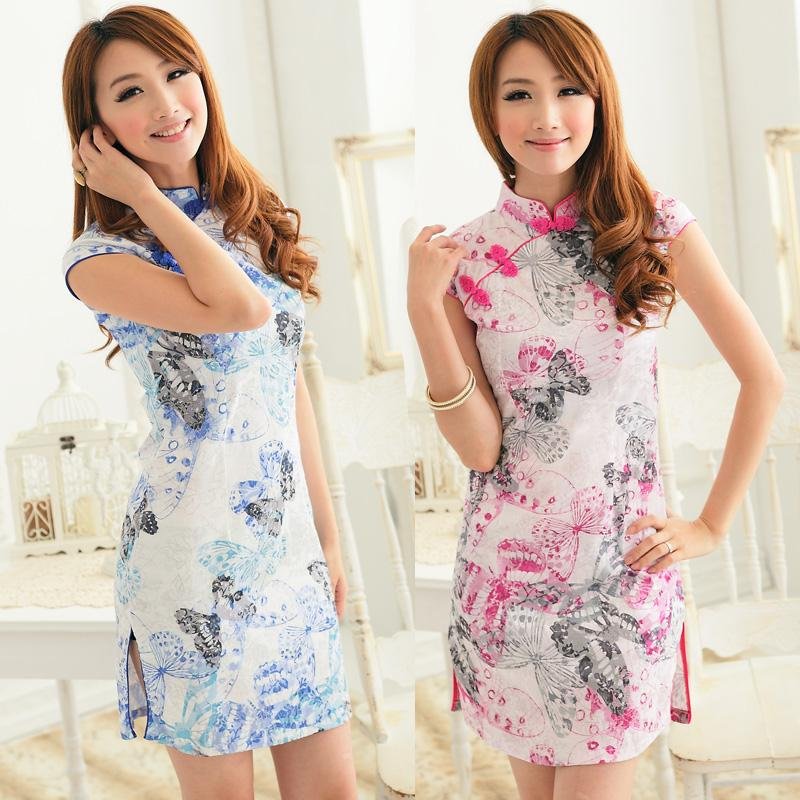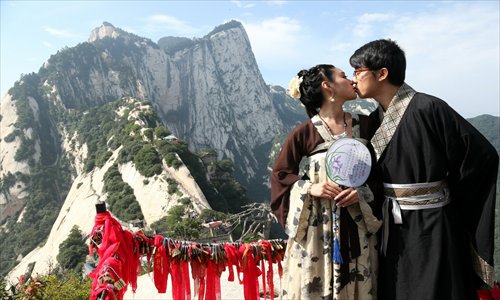A couple celebrating the Qixi Festival in traditional hanfu. Photo: CFP
Outfitted in a tall black hat and floor-length robe with loose sleeves, 27-year-old Li Baichuan could be mistaken for his Han ancestors who lived centuries ago if it weren't for his modern glasses and cellphone.
Although his traditional outfit provokes reactions and attracts attention from passersby, Li, and thousands of hobbyists like him, believe it is important to revive the traditions and lifestyle of their Han ancestors. Donning hanfu, a set of traditional Han clothing composed of several layers - most notably, a ground-sweeping robe - is their most overt attempt at bringing Han style back.
Nowadays, hanfu is usually only worn by hobbyists or participants in cultural exercises, but some religious figures, like Taoists and Buddhist monks, wear the garments every day.
Traditional hanfu is a set consisting of two or three layers. A light T-shirt and shorts set is worn under a long, wide-sleeved robe, and a typical set may also include a hat, sashes worn to secure the robe and a jacket that stays open at the front.
Li, who makes traditional Han clothing items by hand and sells them, wears a robe that follows an ancient pattern, with the left side of the robe diagonally crossed over the right. He chose red cuff and collar accents to set off his black robe.
To promote the use of hanfu, Li taught himself how to tailor the traditional garments, and he hopes to make the clothes shorter and more convenient for people to wear today.
Li has sold nine hanfu sets in the past two weeks.
"Young customers are more individualistic, and they willfully change patterns and match colors," he said.
Even Li wears modern clothes like button-down shirts and sweaters beneath his hanfu robe, allowing the collars of his contemporary wardrobe to poke out from under the traditional robe.
On the fringe
Li has found it difficult to convince the public in China, which is largely Han, to accept and adopt the traditional clothing of their ancestors.
In 1644, the Manchu rulers of the Qing Dynasty (1644-1911) ordered all Han people to adopt Manchu-style clothing or face harsh punishment.
The hanfu style was gradually replaced by Manchu style, which offered the cheongsam, or qipao, for women and the changshan for men.
After feudalism was overthrown in 1911, the changshan and other similar clothing styles were gradually replaced by Western fashion in China.
Only in the past 10 years have people started to call for a revival of Han Chinese clothing, donning such clothes in daily life, during festivals or on other special occasions, according to Li Baichuan.
When he started to wear hanfu in public, Li was often mistaken for a street performer or a Japanese person, as the hanfu robe looks a lot like a Japanese kimono.
For the sake of authenticity, he felt a dagger tied to his robe was a must-have accessory, but the dagger once prompted police to escort him out of a subway station.
Li also said it is difficult to find people who understand the message that hanfu hobbyists are trying to convey, especially in small towns.
Most hanfu hobbyists in China are from big cities. While no figure is available on the exact number of such hobbyists, about 2,000 to 3,000 live in Beijing, according to Li's estimates.
He also estimates that most hanfu hobbyists are in their 20s and 30s and that few have adopted hanfu as part of their everyday, public wardrobes.
Hobbyists join small clubs that rely heavily on personal contributions from members, and their meet-ups, which include costume shows, exhibitions and a pitch-pot game that was a popular way to entertain guests in ancient times, are usually held in parks and other free venues, he said.
Fashion statement
Hanfu sparked debate in 2007, when Chinese political advisor Ye Hongming proposed adopting hanfu as China's national clothing.
Supporters said popularizing hanfu would boost national pride and promote national unity, and they believed that such clothing called to mind China's ancient glories and could best represent China on formal occasions.
Others said the move was unnecessary and a symbol of Han chauvinism. "Why not the garments of ethnic minorities?" "A nation and its culture are not judged by their cover," Internet users wrote.
Prominent Chinese writer Yu Qiuyu labeled the proposal "nationalistic," arguing that people's freedom of choice would be undermined if everyone were required to wear hanfu on important occasions.
The hanfu battle fired back up this month after pictures of a university student in East China wearing hanfu were posted on online forums.
Qin Yawen, a college student from China's Soochow University, said TV shows inspired her to dress in hanfu, but others derided her actions as fame-seeking.
Wang Zhi, a Xi'an-based folklore expert, said that amid a backdrop of globalization, people are craving a unique cultural identity, which has aroused an interest in hanfu.
People have become worried about losing their identity, and they want to trace their roots, finding something that's unique about them, he said.
He Tongbin, a lecturer in the School of Liberal Arts at Nanjing University, believes that globalization has become such an indelible cultural influence that the promotion of hanfu can do little to help modern Chinese people to revive cultural traditions that were lost long ago.
It's hard to live like the ancestors, even for hanfu campaigners, he said.















